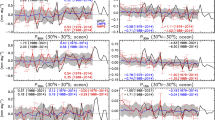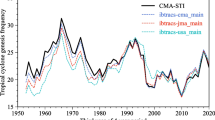Abstract
An animated analysis of the data of global radiothermal satellite monitoring carried out in August 2000 has been applied to study the processes of evolution of tropical cyclones in the Northern Hemisphere. The crucial role of tropospheric advective latent heat fluxes within the rapid intensification of the tropical cyclone has been identified and confirmed by existing examples. The main disturbing factor that introduces significant errors into the evaluations by this approach is the proximity of large landmasses; hence a deeper analysis requires a preliminary selection of tropical cyclones moving over the ocean-water space away from the shoreline as objects of study. Proposals for further improving the analysis technique aimed at a detailed investigation of individual phases of a tropical cyclone evolution using large arrays of radiothermal remote data are formulated.







Similar content being viewed by others
REFERENCES
Ali, M., Swain, D., Kashyap, T., McCreary, J., and Nagamani, P., Relationship between cyclone intensities and sea surface temperature in the tropical Indian Ocean, IEEE Geosci. Remote Sens. Lett., 2013, vol. 10, no. 4, pp. 841–844.
Ermakov, D.M., Raev, M.D., Suslov, A.I., and Sharkov, E.A., Electronic long-term database of global radiothermal field of the Earth in the context of multiscale investigation of the ocean-atmosphere system, Issled. Zemli Kosmosa, 2007, no. 1, pp. 7–13.
Ermakov, D.M., Chernushich, A.P., Sharkov, E.A., and Shramkov, Ya.N., Possibility of the construction of short-term global radiothermal images of the ocean–atmosphere system on the basis of the Stream Handler programming platform, Sovrem. Probl. Distantsionnogo Zondirovaniya Zemli Kosmosa, 2011, vol. 8, no. 3, pp. 9–16.
Ermakov, D.M., Chernushich, A.P., Sharkov, E.A., and Pokrovskaya, I.V., Searching for an energy source of the intensification of tropical cyclone Katrina using microwave satellite sensing data, Issled. Zemli Kosmosa, 2012a, no. 4, pp. 47–56.
Ermakov, D.M., Chernushich, A.P., and Sharkov, E.A., Detailing the developmental phases of TC Katrina on interpolated global fields of water vapor, Sovrem. Probl. Distantsionnogo Zondirovaniya Zemli Kosmosa, 2012b, vol. 9, no. 2, pp. 207–213.
Ermakov, D.M., Raev, M.D., Chernushich, A.P., and Sharkov, E.A., Algorithm of the construction of global radiothermal fields of the ocean–atmosphere system using microwave satellite data of high spatial and temporal resolution, Issled. Zemli Kosmosa, 2013a, no. 4, pp. 72–82.
Ermakov, D.M., Sharkov, E.A., and Chernushich, A.P., Animation analysis of precedents of rapid intensification of tropical cyclones Tez. dokl. Mezhd. konf. “Distantsionnoe zondirovanie okruzhayushchei sredy: nauchnye i prikladnye issledovaniya v Aziatsko–Tikhookeanskom regione (RSAP2013)” (Abstracts of the International Conference “Remote Sensing of the Environment: Scientific and Applied Studies in the Asia–Pacific Region (RSAP2013)”), Vladivostok, 2013b, pp. 63–64.
Ermakov, D.M., Sharkov, E.A., Pokrovskaya, I.V., and Chernushich, A.P., Revealing energy sources in intermittent intensity modes of the Alberto TC during its evolution according to satellite microwave sensing data, Issled. Zemli Kosmosa, 2013c, no. 4, pp. 39–49.
Ermakov, D.M., Sharkov, E.A., and Chernushich, A.P., Evaluation of tropospheric advective fluxes of latent heat over the ocean by animation analysis of radiothermal data of satellite monitoring, Issled. Zemli Kosmosa, 2014, no. 4, pp. 32–38.
Kaplan, J., DeMaria, M., and Knaff, J.A., A revised tropical cyclone rapid intensification index for the Atlantic and Eastern North Pacific basins, Weather Forecast, 2010, vol. 25, pp. 220–241.
Nerushev, A.F. and Kramchaninova, E.K., Method for determining atmospheric motion characteristics using measurements on geostationary meteorological satellites, Izv., Atmos. Ocean. Phys., 2011, vol. 47, no. 9, pp. 1104–1113.
Palmén, E. and Newton, C., Atmospheric Circulation Systems, New York: Academic, 1969; Leningrad: Gidrometeoizdat, 1973.
Permyakov, M.S., Tropical cyclones: Formation, development, and interaction with the ocean, Extended Abstract of Dr. Sci. Dissertation, Vladivostok. 2006.
Pokrovskaya, I.V. and Sharkov, E.A., Tropicheskie tsiklony i tropicheskie vozmushcheniya Mirovogo okeana: khronologiya i evolyutsiya. Vers. 3.1. (1983–2005) (Tropical Cyclones and Tropical Disturbances of the World Ocean: Chronology and Evolution). Version 3.1 (1983–2005), Moscow: Poligraf servis, 2006.
Pokrovskaya, I.V. and Sharkov, E.A., Tropicheskie tsiklony i tropicheskie vozmushcheniya Mirovogo okeana: khronologiya i evolyutsiya. Vers. 3.1. (2006–2010) (Tropical Cyclones and Tropical Disturbances of the World Ocean: Chronology and Evolution). Version 4.1 (2006–2010), Moscow: KDU, 2011.
Rostovtseva, V.V. and Goncharenko, I.V., Temporal and spatial statistics of the temperature–humidity signature of tropical cyclone generation according to satellite microwave radiometry, Issled. Zemli Kosmosa, 2010, no. 4, pp. 32–40.
Sharkov, E.A., Global Tropical Cyclogenesis, Berlin: Springer, 2000.
Sharkov, E.A., Universal constant of the generation of the stochastic mode of global tropical cyclogenesis in the context of climatic variations, Issled. Zemli Kosmosa, 2009, no. 6, pp. 31–38.
Sharkov, E.A., Kim, G.A., and Pokrovskaya, I.V., Energy features of plural tropical cyclogenesis from multispectral satellite observations, Izv., Atmos. Ocean. Phys., 2011a, vol. 47, no. 9, pp. 1084–1091.
Sharkov, E.A., Shramkov, Ya.N., and Pokrovskaya, I.V., Features of water vapor equatorial field during tropical cyclone (TC) evolution by the example of the Francisco TC (2001), Sovrem. Probl. Distantsionnogo Zondirovaniya Zemli Kosmosa, 2011b, vol. 8, no. 3, pp. 310–316.
Sharkov, E.A., Shramkov, Ya.N., and Pokrovskaya, I.V., Boundary parameter of tropical cyclone genesis in the global integral water vapor field, Sovrem. Probl. Distantsionnogo Zondirovaniya Zemli Kosmosa, 2011c, vol. 8, no. 1, pp. 280–286.
Sharkov, E.A., Remote investigations of atmospheric catastrophes, Izv., Atmos. Ocean. Phys., 2011d, vol. 47, no. 9, pp. 1057–1071.
Sharkov, E.A., Shramkov, Ya.N., and Pokrovskaya, I.V., Increased water-vapor content in the atmosphere of tropical latitudes as a necessary condition for the genesis of tropical cyclones, Izv., Atmos. Ocean. Phys., 2012, vol. 48, no. 9, pp. 900–908.
Wimmers, A.J. and Velden, C.S., MIMIC: A new approach to visualizing satellite microwave imagery of tropical cyclones, Bull. Am. Meteorol. Soc., 2007, vol. 88, no. 8, pp. 1187–1196.
Wimmers, A.J. and Velden, C.S., Seamless advective blending of total precipitable water retrievals from polar-orbiting satellites, J. Appl. Meteorol. Climatol., 2011, vol. 50, no. 5, pp. 1024–1036.
Zheng, G. and Tang, D., Offshore and nearshore chlorophyll increases induced by typhoon winds and subsequent terrestrial rainwater runoff, Mar. Ecol.: Proc. Ser., 2007, vol. 333, pp. 61–74.
Zhao, H., Tang, D., and Wang, Y., Comparison of phytoplankton blooms triggered by two typhoons with different intensities and translation speeds in the South China Sea, Mar. Ecol.: Proc. Ser., 2008, vol. 365, pp. 57–65.
Funding
The paper was supported by the Russian Foundation for Basic Research, project no. 13-07-00513A.
Author information
Authors and Affiliations
Corresponding author
Additional information
Translated by N. Semenova
Rights and permissions
About this article
Cite this article
Ermakov, D.M., Sharkov, E.A. & Chernushich, A.P. Role of Tropospheric Latent Heat Advective Fluxes in the Intensification of Tropical Cyclones. Izv. Atmos. Ocean. Phys. 55, 1254–1265 (2019). https://doi.org/10.1134/S0001433819090172
Received:
Published:
Issue Date:
DOI: https://doi.org/10.1134/S0001433819090172




